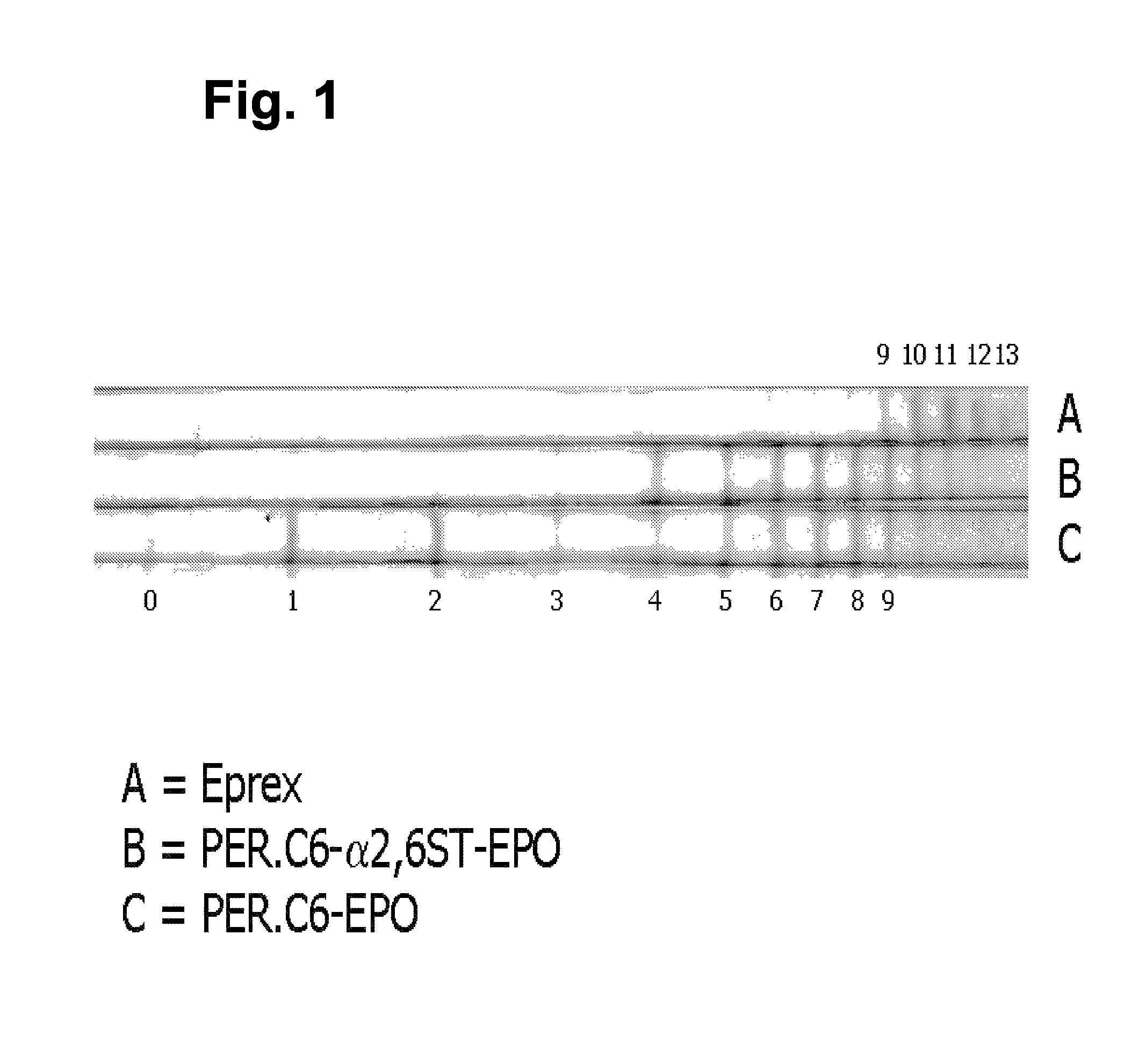Methods to obtain recombinant proteins with increased sialylation from cells that express adenovirus E1A protein, and proteins obtained thereby
a technology of adenovirus e1a and recombinant proteins, which is applied in the field of recombinant protein production, can solve the problems of unsuitable treatment of anemia, unpredictable results of over-expression of sialyltransferase in such cells, and unpredictability of the glycosylation pattern of proteins thus produced
- Summary
- Abstract
- Description
- Claims
- Application Information
AI Technical Summary
Benefits of technology
Problems solved by technology
Method used
Image
Examples
example 1
Increased Sialylation of EPO Produced in PER.C6 Cells by the Over-Expression of α2,6-sialyltransferase
[0065]To determine the effect of over-expression of α2,6-sialyltransferase on the sialylation of EPO produced in PER.C6 cells, EPO was produced in adherent cultures of an α-2,6-sialyltransferase over-expressing PER.C6 cell line, i.e., PER.C6-EPO-ST clone 25-3.10 (see example 2 of WO 03 / 048348, incorporated by reference), and in the parental cell line PER.C6-EPO clone 25 not over-expressing the α2,6-sialyltransferase. The cells were first cultured in T-flasks in DMEM+10 mM MgCl2+9% FBS. At the moment that the cells were grown to 60-70% confluency, the serum containing medium was replaced by DMEM+10 mM MgCl2 without serum. The culture was then continued at 37° C. and 10% CO2 for 3-4 days. The culture supernatant was thereafter harvested and EPO was purified and analyzed using methods that have been described in WO 03 / 038100, the contents of the entirety of which are incorporated by th...
example 2
Increased Level of Galactosylation and Fucosylation of EPO Produced in PER.C6 Cells Through the Adaptation of the Cells to Growth in Suspension in Serum-Free Medium
[0066]The stable PER.C6 cell line, PER.C6-022, producing EPO was used to assess the level of galactosylation of EPO when the cells were cultured adherently (using methods described in example 1) and when the cells were adapted to growth in serum-free medium. For the latter, a procedure was developed to produce EPO in PER.C6 cells that were cultured in suspension in serum free medium. The procedure is described below and was applied to several EPO-producing PER.C6 cell lines. PER.C6-EPO-022 cells were used to produce EPO with N-linked glycans structures that are typical for non-modified PER.C6 cells as described in WO 03 / 038100.
[0067]For the production of PER.C6-EPO, the above indicated cell line was adapted to a serum-free medium, i.e., Excell 525 (JRH Biosciences). Therefore, the cells were first cultured to form a 70%-9...
example 3
Level of Sialylation is Further Increased in Cells that Over-Express α2,6-Sialyltransferase and that are Cultured in Suspension in a Serum-Free Medium
[0076]We reasoned that the increased level of galactosylation in suspension cultures in serum-free medium would be beneficial in obtaining a higher level of sialylation in cells that over-express the α2,6-sialyltransferase because the increased galactosylation results in the formation of more GlcNAc-Gal structures to which a sialic acid can be linked. Therefore, PER.C6-EPO clone 25-3.10 was adapted to suspension culture in serum-free medium and EPO was produced in VPRO medium as described in example 2.
[0077]The sialic acid content of EPO was analyzed using iso-electric focusing, which was performed essentially as described in WO 03 / 038100. Instead of visualizing EPO using Western blot analysis, EPO was stained with colloidal blue (Novex). The bands represent EPO isoforms containing different amounts of sialic acids per EPO molecule. Th...
PUM
| Property | Measurement | Unit |
|---|---|---|
| pH | aaaaa | aaaaa |
| flow rate | aaaaa | aaaaa |
| pH | aaaaa | aaaaa |
Abstract
Description
Claims
Application Information
 Login to View More
Login to View More - R&D
- Intellectual Property
- Life Sciences
- Materials
- Tech Scout
- Unparalleled Data Quality
- Higher Quality Content
- 60% Fewer Hallucinations
Browse by: Latest US Patents, China's latest patents, Technical Efficacy Thesaurus, Application Domain, Technology Topic, Popular Technical Reports.
© 2025 PatSnap. All rights reserved.Legal|Privacy policy|Modern Slavery Act Transparency Statement|Sitemap|About US| Contact US: help@patsnap.com



